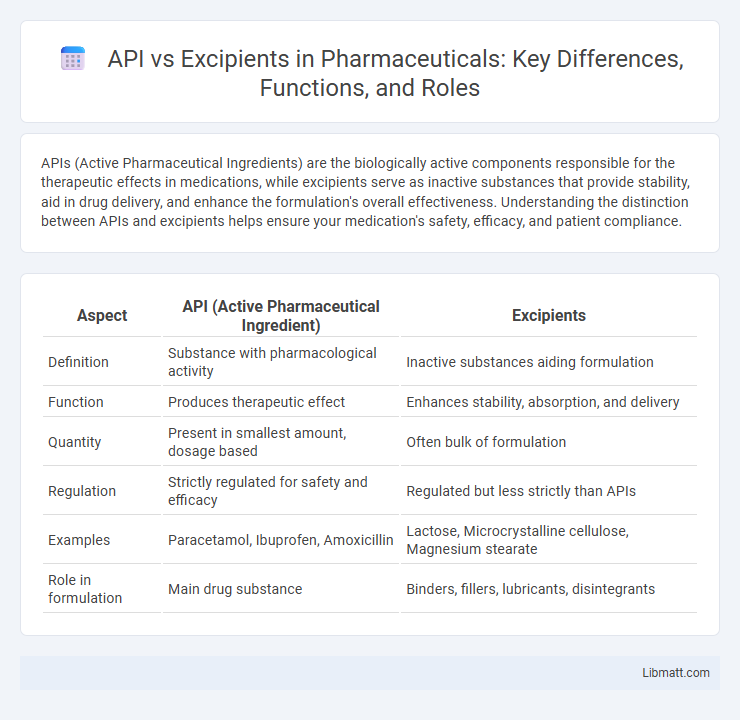APIs (Active Pharmaceutical Ingredients) are the biologically active components responsible for the therapeutic effects in medications, while excipients serve as inactive substances that provide stability, aid in drug delivery, and enhance the formulation's overall effectiveness. Understanding the distinction between APIs and excipients helps ensure your medication's safety, efficacy, and patient compliance.
Table of Comparison
| Aspect | API (Active Pharmaceutical Ingredient) | Excipients |
|---|---|---|
| Definition | Substance with pharmacological activity | Inactive substances aiding formulation |
| Function | Produces therapeutic effect | Enhances stability, absorption, and delivery |
| Quantity | Present in smallest amount, dosage based | Often bulk of formulation |
| Regulation | Strictly regulated for safety and efficacy | Regulated but less strictly than APIs |
| Examples | Paracetamol, Ibuprofen, Amoxicillin | Lactose, Microcrystalline cellulose, Magnesium stearate |
| Role in formulation | Main drug substance | Binders, fillers, lubricants, disintegrants |
Introduction to APIs and Excipients
Active Pharmaceutical Ingredients (APIs) are the primary substances in medications responsible for therapeutic effects, while excipients are inactive components that support the formulation by enhancing stability, absorption, and taste. Your understanding of APIs and excipients helps in recognizing how each contributes to the safety, efficacy, and delivery of pharmaceutical products. APIs deliver the intended medicinal action, whereas excipients optimize drug performance and patient experience.
Defining Active Pharmaceutical Ingredients (APIs)
Active Pharmaceutical Ingredients (APIs) are the biologically active components in medications responsible for the therapeutic effects, distinguished from excipients which serve as inactive substances facilitating drug delivery and stability. APIs undergo rigorous chemical synthesis or extraction processes to ensure purity, potency, and efficacy in pharmaceutical formulations. The precise identification and quantification of APIs are critical for drug safety, regulatory compliance, and efficacy in clinical use.
Understanding Excipients in Drug Formulation
Excipients play a critical role in drug formulation by enhancing the stability, bioavailability, and delivery of the Active Pharmaceutical Ingredient (API). Common excipients such as binders, fillers, disintegrants, and lubricants ensure the consistent dosage, ease of administration, and patient acceptability of the final pharmaceutical product. Understanding the physicochemical properties of excipients helps optimize the therapeutic efficacy and safety profile of drugs.
Key Differences Between APIs and Excipients
Active Pharmaceutical Ingredients (APIs) are the substances in medications responsible for therapeutic effects, whereas excipients serve as inactive components that aid in drug formulation and stability. APIs provide the pharmacological activity targeting specific conditions, while excipients enhance product delivery, taste, preservation, and manufacturability without exerting therapeutic effects. The distinction lies in APIs being pharmacologically active and excipients functioning as supportive agents within pharmaceutical formulations.
Roles of APIs vs Excipients in Pharmaceuticals
Active Pharmaceutical Ingredients (APIs) are the biologically active components responsible for the therapeutic effects of medications, targeting specific conditions or diseases. Excipients serve as inactive substances that aid in the drug's stability, absorption, delivery, and overall manufacturability without exerting pharmacological effects. The precise formulation and balance between APIs and excipients ensure drug efficacy, safety, and patient compliance in pharmaceutical products.
Types and Examples of APIs
Active Pharmaceutical Ingredients (APIs) are the biologically active components in medications responsible for therapeutic effects, whereas excipients serve as inactive substances that facilitate drug formulation and delivery. Types of APIs include small molecule drugs like acetaminophen and ibuprofen, biologics such as monoclonal antibodies and vaccines, and natural extracts like paclitaxel derived from the Pacific yew tree. Your understanding of these API types enhances insight into how medications function and the critical role each ingredient plays in treatment efficacy.
Common Excipients and Their Functions
Common excipients in pharmaceutical formulations include fillers like lactose and microcrystalline cellulose, which provide bulk to tablets and capsules. Binders such as povidone and hydroxypropyl methylcellulose enhance tablet cohesion and mechanical strength. Disintegrants like croscarmellose sodium facilitate tablet breakup for faster drug release, while lubricants such as magnesium stearate improve manufacturing efficiency by reducing friction.
Importance of API and Excipient Compatibility
Compatibility between the Active Pharmaceutical Ingredient (API) and excipients is crucial to ensure drug stability, efficacy, and safety throughout the product's shelf life. Incompatible combinations can lead to degradation, reduced bioavailability, or adverse reactions, impacting therapeutic outcomes. Understanding the chemical and physical interactions between the API and excipients helps optimize formulation and maintain your medication's quality.
Regulatory Considerations for APIs and Excipients
Regulatory considerations for APIs (Active Pharmaceutical Ingredients) require strict compliance with Good Manufacturing Practices (GMP) and detailed documentation to ensure safety, purity, and efficacy. Excipients must meet quality standards established by pharmacopeias and regulatory agencies, although they often face less rigorous approval processes compared to APIs. Understanding these differences helps you navigate the regulatory landscape effectively during drug formulation and approval.
Conclusion: The Synergy of APIs and Excipients in Drug Development
APIs (Active Pharmaceutical Ingredients) provide the therapeutic effect, while excipients enhance stability, bioavailability, and patient compliance. The synergy of APIs and excipients is critical for optimizing drug efficacy, safety, and delivery mechanisms. Effective drug development relies on precise formulation that balances API potency with excipient functionality.
API vs Excipients Infographic

 libmatt.com
libmatt.com